BSBSUS401: Implement & Monitor Environmentally Sustainable Work
VerifiedAdded on 2024/07/02
|22
|4143
|304
Practical Assignment
AI Summary
This assignment solution for BSBSUS401 focuses on implementing and monitoring environmentally sustainable work practices, specifically within the context of the Hilton Hotel in Australia. It covers identifying relevant environmental regulations and initiatives, measuring current consumption of resources like gas, electricity, and water, and setting efficiency targets. The solution includes an analysis of existing work practices and purchasing strategies, identification of potential environmental breaches, and proposes strategies for improving resource efficiency, including waste management, energy consumption, and water conservation. Furthermore, it details methods for ensuring staff compliance, evaluating strategies, and monitoring progress through tools like periodic inventory systems and milestones, concluding with potential savings calculations and communication strategies.
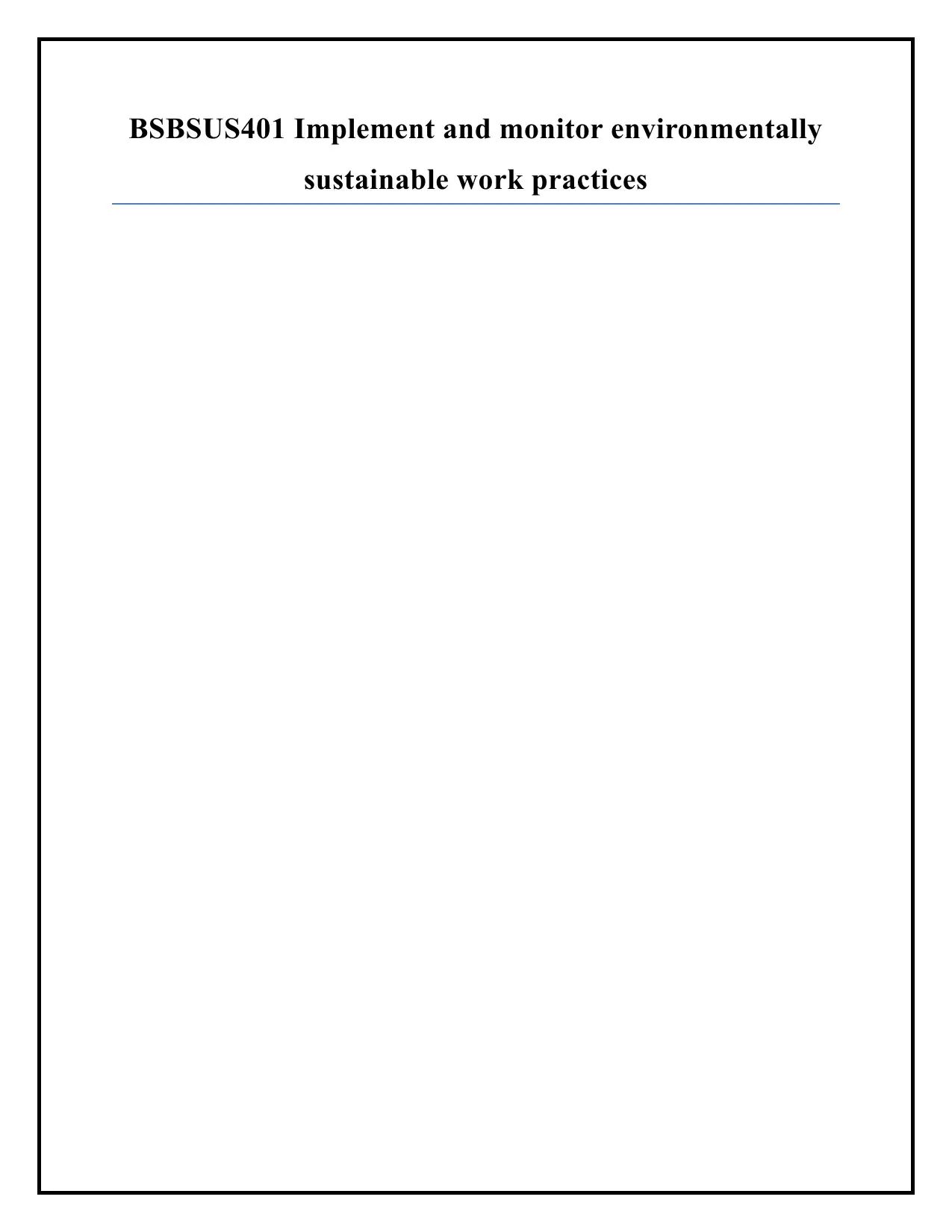
BSBSUS401 Implement and monitor environmentally
sustainable work practices
sustainable work practices
Paraphrase This Document
Need a fresh take? Get an instant paraphrase of this document with our AI Paraphraser
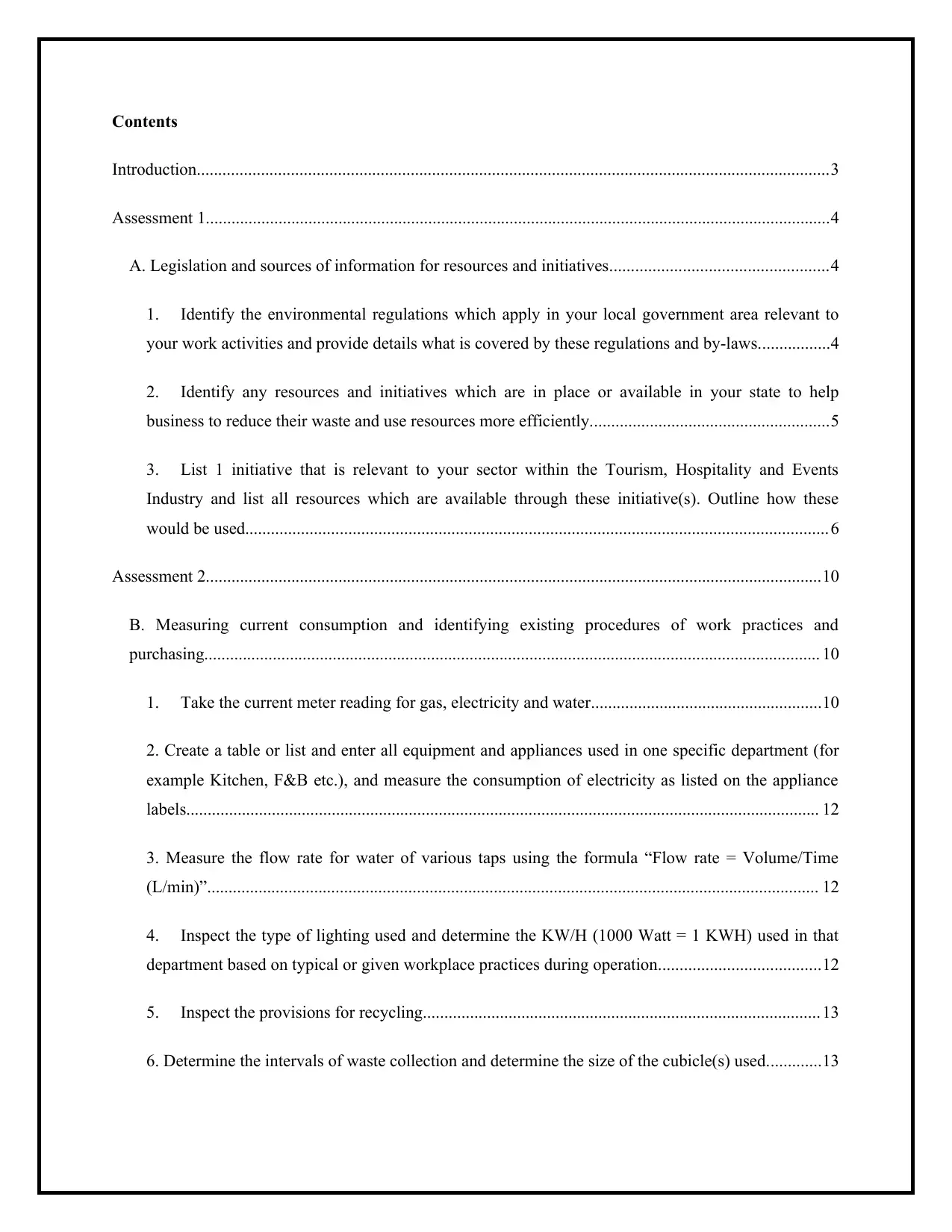
Contents
Introduction....................................................................................................................................................3
Assessment 1..................................................................................................................................................4
A. Legislation and sources of information for resources and initiatives...................................................4
1. Identify the environmental regulations which apply in your local government area relevant to
your work activities and provide details what is covered by these regulations and by-laws.................4
2. Identify any resources and initiatives which are in place or available in your state to help
business to reduce their waste and use resources more efficiently........................................................5
3. List 1 initiative that is relevant to your sector within the Tourism, Hospitality and Events
Industry and list all resources which are available through these initiative(s). Outline how these
would be used........................................................................................................................................6
Assessment 2................................................................................................................................................10
B. Measuring current consumption and identifying existing procedures of work practices and
purchasing................................................................................................................................................ 10
1. Take the current meter reading for gas, electricity and water......................................................10
2. Create a table or list and enter all equipment and appliances used in one specific department (for
example Kitchen, F&B etc.), and measure the consumption of electricity as listed on the appliance
labels.................................................................................................................................................... 12
3. Measure the flow rate for water of various taps using the formula “Flow rate = Volume/Time
(L/min)”............................................................................................................................................... 12
4. Inspect the type of lighting used and determine the KW/H (1000 Watt = 1 KWH) used in that
department based on typical or given workplace practices during operation......................................12
5. Inspect the provisions for recycling.............................................................................................13
6. Determine the intervals of waste collection and determine the size of the cubicle(s) used.............13
Introduction....................................................................................................................................................3
Assessment 1..................................................................................................................................................4
A. Legislation and sources of information for resources and initiatives...................................................4
1. Identify the environmental regulations which apply in your local government area relevant to
your work activities and provide details what is covered by these regulations and by-laws.................4
2. Identify any resources and initiatives which are in place or available in your state to help
business to reduce their waste and use resources more efficiently........................................................5
3. List 1 initiative that is relevant to your sector within the Tourism, Hospitality and Events
Industry and list all resources which are available through these initiative(s). Outline how these
would be used........................................................................................................................................6
Assessment 2................................................................................................................................................10
B. Measuring current consumption and identifying existing procedures of work practices and
purchasing................................................................................................................................................ 10
1. Take the current meter reading for gas, electricity and water......................................................10
2. Create a table or list and enter all equipment and appliances used in one specific department (for
example Kitchen, F&B etc.), and measure the consumption of electricity as listed on the appliance
labels.................................................................................................................................................... 12
3. Measure the flow rate for water of various taps using the formula “Flow rate = Volume/Time
(L/min)”............................................................................................................................................... 12
4. Inspect the type of lighting used and determine the KW/H (1000 Watt = 1 KWH) used in that
department based on typical or given workplace practices during operation......................................12
5. Inspect the provisions for recycling.............................................................................................13
6. Determine the intervals of waste collection and determine the size of the cubicle(s) used.............13
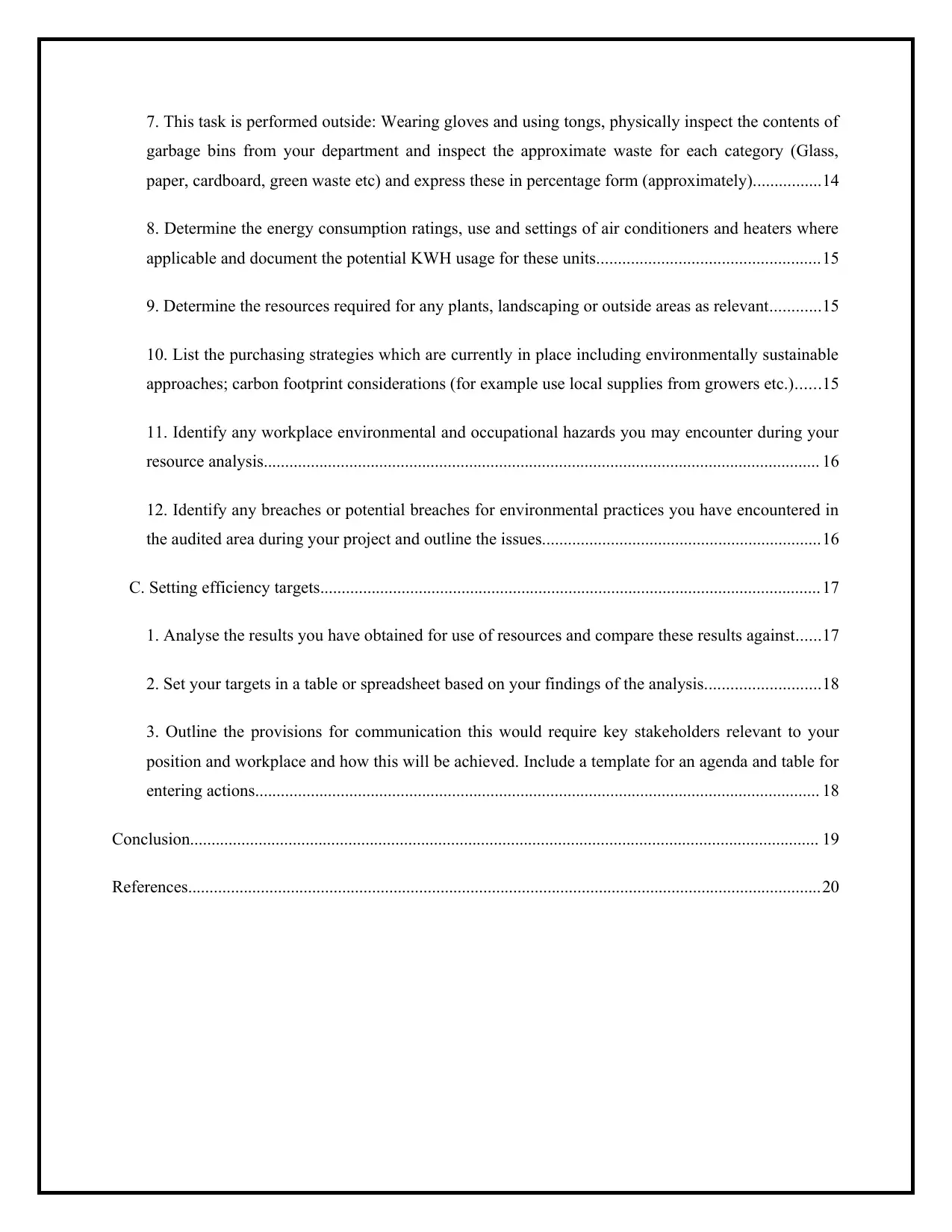
7. This task is performed outside: Wearing gloves and using tongs, physically inspect the contents of
garbage bins from your department and inspect the approximate waste for each category (Glass,
paper, cardboard, green waste etc) and express these in percentage form (approximately)................14
8. Determine the energy consumption ratings, use and settings of air conditioners and heaters where
applicable and document the potential KWH usage for these units....................................................15
9. Determine the resources required for any plants, landscaping or outside areas as relevant............15
10. List the purchasing strategies which are currently in place including environmentally sustainable
approaches; carbon footprint considerations (for example use local supplies from growers etc.)......15
11. Identify any workplace environmental and occupational hazards you may encounter during your
resource analysis.................................................................................................................................. 16
12. Identify any breaches or potential breaches for environmental practices you have encountered in
the audited area during your project and outline the issues.................................................................16
C. Setting efficiency targets.....................................................................................................................17
1. Analyse the results you have obtained for use of resources and compare these results against......17
2. Set your targets in a table or spreadsheet based on your findings of the analysis...........................18
3. Outline the provisions for communication this would require key stakeholders relevant to your
position and workplace and how this will be achieved. Include a template for an agenda and table for
entering actions.................................................................................................................................... 18
Conclusion................................................................................................................................................... 19
References....................................................................................................................................................20
garbage bins from your department and inspect the approximate waste for each category (Glass,
paper, cardboard, green waste etc) and express these in percentage form (approximately)................14
8. Determine the energy consumption ratings, use and settings of air conditioners and heaters where
applicable and document the potential KWH usage for these units....................................................15
9. Determine the resources required for any plants, landscaping or outside areas as relevant............15
10. List the purchasing strategies which are currently in place including environmentally sustainable
approaches; carbon footprint considerations (for example use local supplies from growers etc.)......15
11. Identify any workplace environmental and occupational hazards you may encounter during your
resource analysis.................................................................................................................................. 16
12. Identify any breaches or potential breaches for environmental practices you have encountered in
the audited area during your project and outline the issues.................................................................16
C. Setting efficiency targets.....................................................................................................................17
1. Analyse the results you have obtained for use of resources and compare these results against......17
2. Set your targets in a table or spreadsheet based on your findings of the analysis...........................18
3. Outline the provisions for communication this would require key stakeholders relevant to your
position and workplace and how this will be achieved. Include a template for an agenda and table for
entering actions.................................................................................................................................... 18
Conclusion................................................................................................................................................... 19
References....................................................................................................................................................20
⊘ This is a preview!⊘
Do you want full access?
Subscribe today to unlock all pages.

Trusted by 1+ million students worldwide
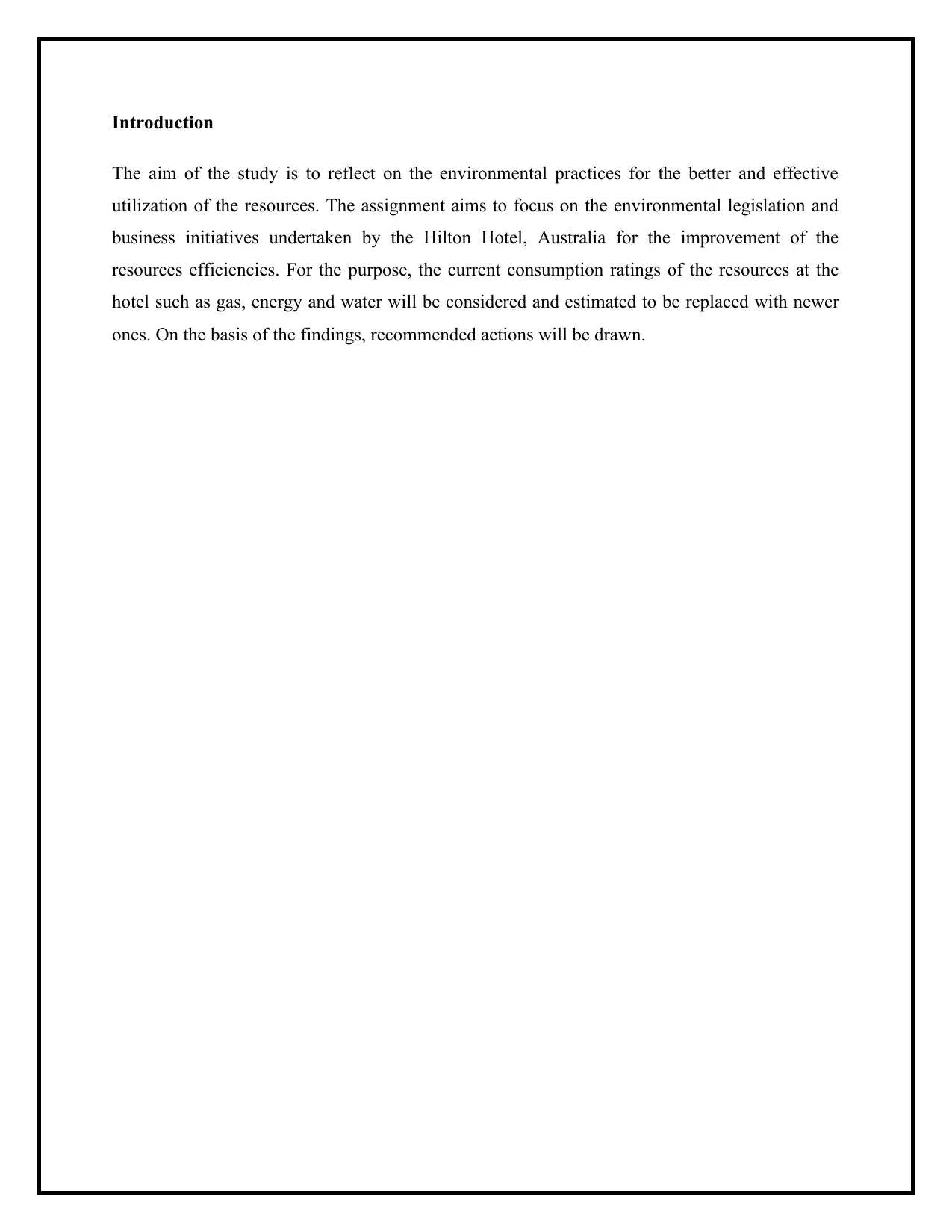
Introduction
The aim of the study is to reflect on the environmental practices for the better and effective
utilization of the resources. The assignment aims to focus on the environmental legislation and
business initiatives undertaken by the Hilton Hotel, Australia for the improvement of the
resources efficiencies. For the purpose, the current consumption ratings of the resources at the
hotel such as gas, energy and water will be considered and estimated to be replaced with newer
ones. On the basis of the findings, recommended actions will be drawn.
The aim of the study is to reflect on the environmental practices for the better and effective
utilization of the resources. The assignment aims to focus on the environmental legislation and
business initiatives undertaken by the Hilton Hotel, Australia for the improvement of the
resources efficiencies. For the purpose, the current consumption ratings of the resources at the
hotel such as gas, energy and water will be considered and estimated to be replaced with newer
ones. On the basis of the findings, recommended actions will be drawn.
Paraphrase This Document
Need a fresh take? Get an instant paraphrase of this document with our AI Paraphraser
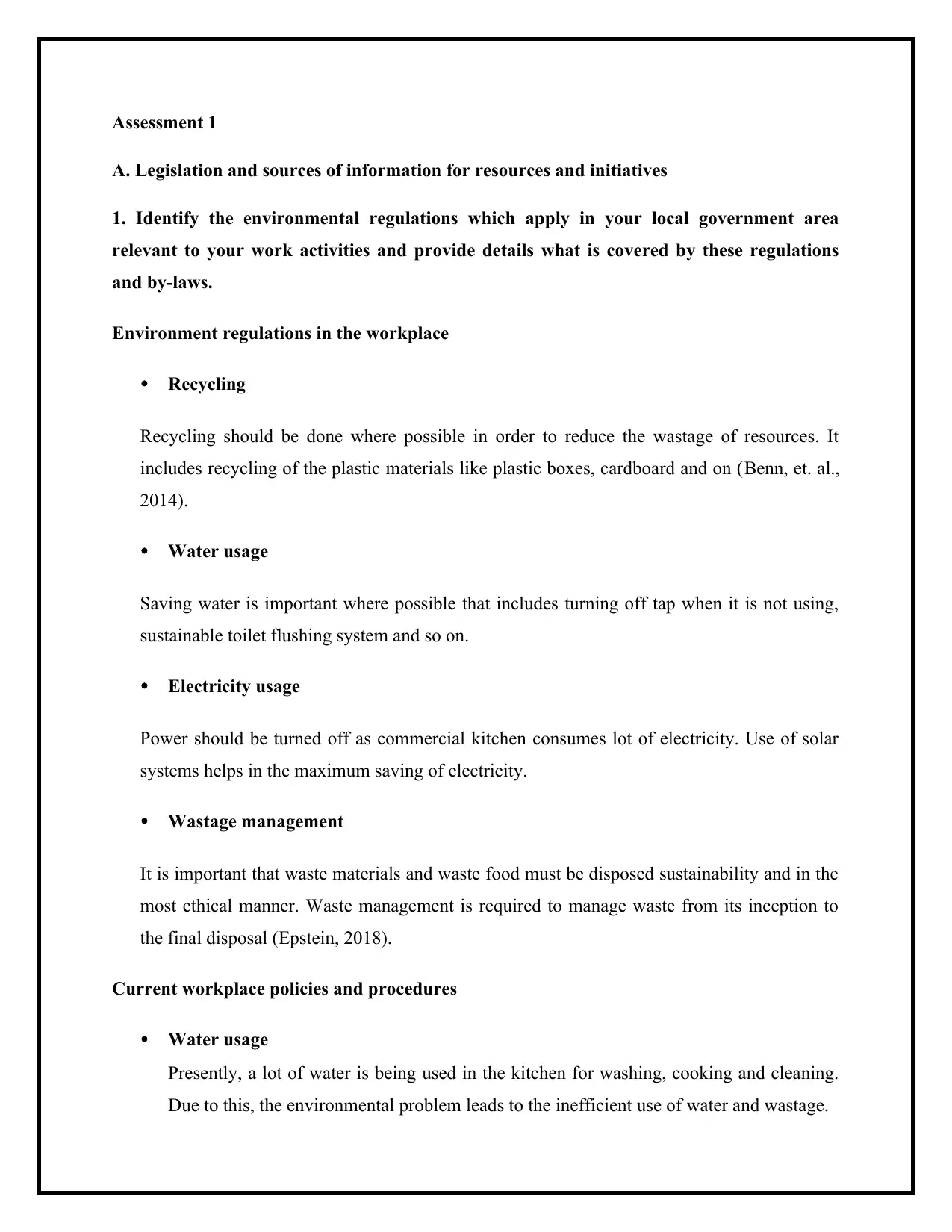
Assessment 1
A. Legislation and sources of information for resources and initiatives
1. Identify the environmental regulations which apply in your local government area
relevant to your work activities and provide details what is covered by these regulations
and by-laws.
Environment regulations in the workplace
Recycling
Recycling should be done where possible in order to reduce the wastage of resources. It
includes recycling of the plastic materials like plastic boxes, cardboard and on (Benn, et. al.,
2014).
Water usage
Saving water is important where possible that includes turning off tap when it is not using,
sustainable toilet flushing system and so on.
Electricity usage
Power should be turned off as commercial kitchen consumes lot of electricity. Use of solar
systems helps in the maximum saving of electricity.
Wastage management
It is important that waste materials and waste food must be disposed sustainability and in the
most ethical manner. Waste management is required to manage waste from its inception to
the final disposal (Epstein, 2018).
Current workplace policies and procedures
Water usage
Presently, a lot of water is being used in the kitchen for washing, cooking and cleaning.
Due to this, the environmental problem leads to the inefficient use of water and wastage.
A. Legislation and sources of information for resources and initiatives
1. Identify the environmental regulations which apply in your local government area
relevant to your work activities and provide details what is covered by these regulations
and by-laws.
Environment regulations in the workplace
Recycling
Recycling should be done where possible in order to reduce the wastage of resources. It
includes recycling of the plastic materials like plastic boxes, cardboard and on (Benn, et. al.,
2014).
Water usage
Saving water is important where possible that includes turning off tap when it is not using,
sustainable toilet flushing system and so on.
Electricity usage
Power should be turned off as commercial kitchen consumes lot of electricity. Use of solar
systems helps in the maximum saving of electricity.
Wastage management
It is important that waste materials and waste food must be disposed sustainability and in the
most ethical manner. Waste management is required to manage waste from its inception to
the final disposal (Epstein, 2018).
Current workplace policies and procedures
Water usage
Presently, a lot of water is being used in the kitchen for washing, cooking and cleaning.
Due to this, the environmental problem leads to the inefficient use of water and wastage.
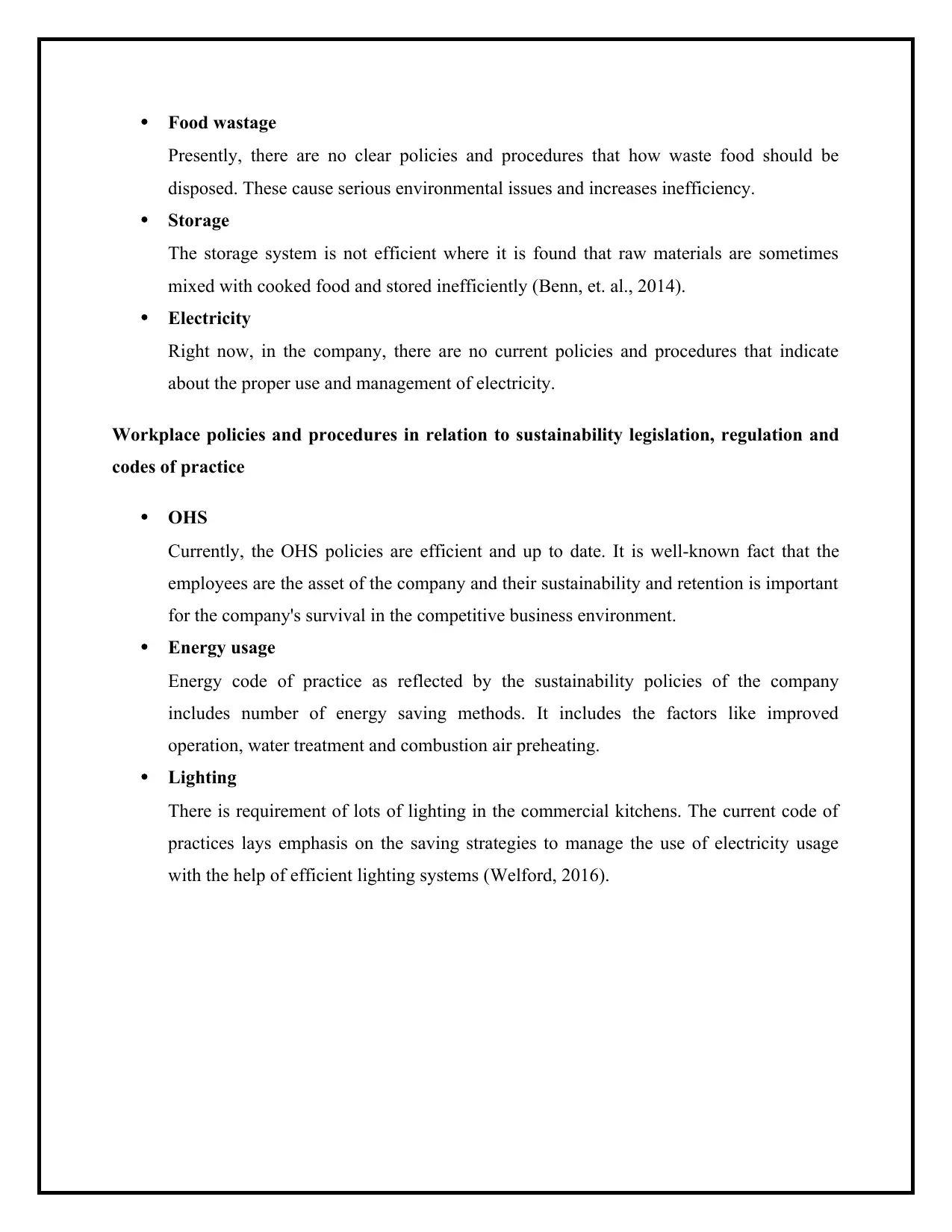
Food wastage
Presently, there are no clear policies and procedures that how waste food should be
disposed. These cause serious environmental issues and increases inefficiency.
Storage
The storage system is not efficient where it is found that raw materials are sometimes
mixed with cooked food and stored inefficiently (Benn, et. al., 2014).
Electricity
Right now, in the company, there are no current policies and procedures that indicate
about the proper use and management of electricity.
Workplace policies and procedures in relation to sustainability legislation, regulation and
codes of practice
OHS
Currently, the OHS policies are efficient and up to date. It is well-known fact that the
employees are the asset of the company and their sustainability and retention is important
for the company's survival in the competitive business environment.
Energy usage
Energy code of practice as reflected by the sustainability policies of the company
includes number of energy saving methods. It includes the factors like improved
operation, water treatment and combustion air preheating.
Lighting
There is requirement of lots of lighting in the commercial kitchens. The current code of
practices lays emphasis on the saving strategies to manage the use of electricity usage
with the help of efficient lighting systems (Welford, 2016).
Presently, there are no clear policies and procedures that how waste food should be
disposed. These cause serious environmental issues and increases inefficiency.
Storage
The storage system is not efficient where it is found that raw materials are sometimes
mixed with cooked food and stored inefficiently (Benn, et. al., 2014).
Electricity
Right now, in the company, there are no current policies and procedures that indicate
about the proper use and management of electricity.
Workplace policies and procedures in relation to sustainability legislation, regulation and
codes of practice
OHS
Currently, the OHS policies are efficient and up to date. It is well-known fact that the
employees are the asset of the company and their sustainability and retention is important
for the company's survival in the competitive business environment.
Energy usage
Energy code of practice as reflected by the sustainability policies of the company
includes number of energy saving methods. It includes the factors like improved
operation, water treatment and combustion air preheating.
Lighting
There is requirement of lots of lighting in the commercial kitchens. The current code of
practices lays emphasis on the saving strategies to manage the use of electricity usage
with the help of efficient lighting systems (Welford, 2016).
⊘ This is a preview!⊘
Do you want full access?
Subscribe today to unlock all pages.

Trusted by 1+ million students worldwide
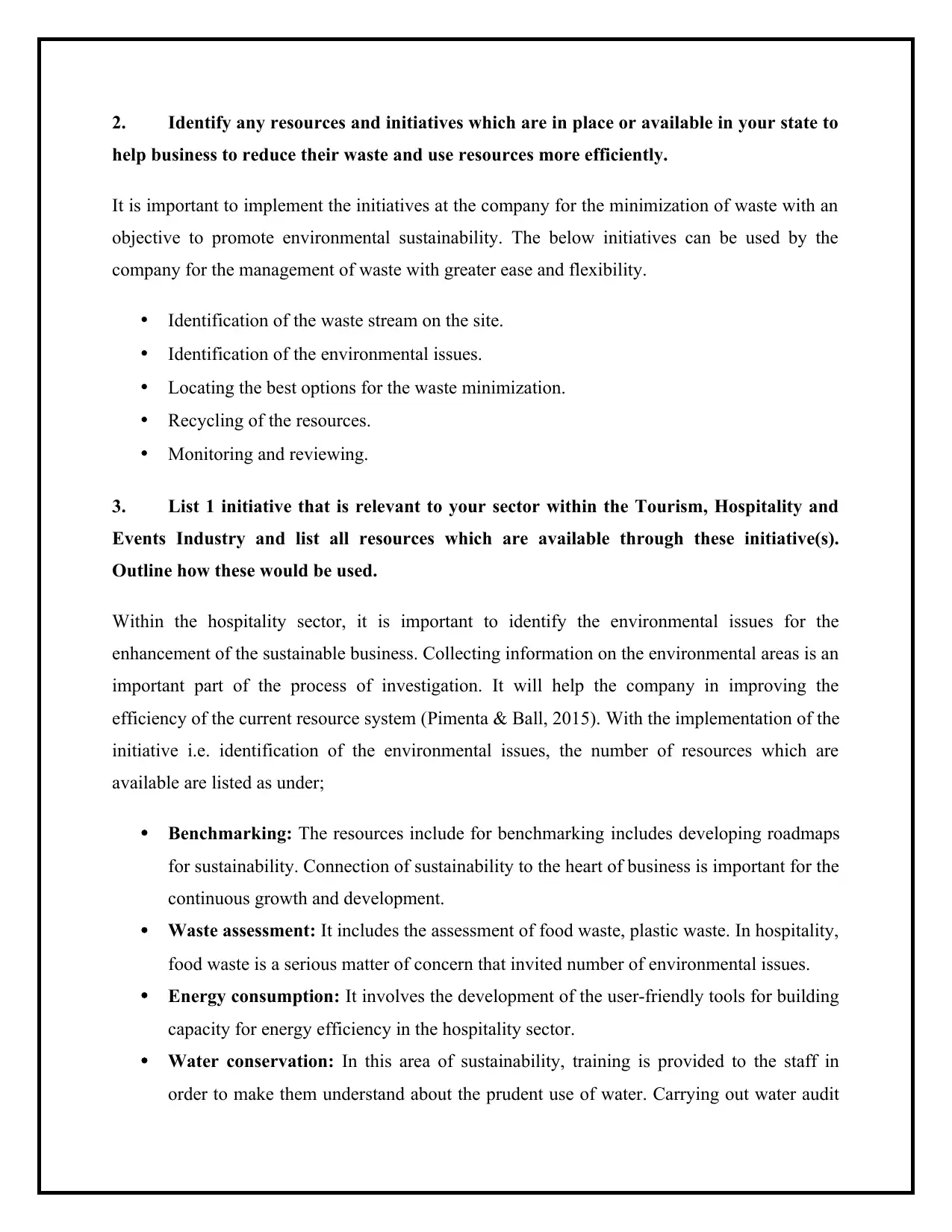
2. Identify any resources and initiatives which are in place or available in your state to
help business to reduce their waste and use resources more efficiently.
It is important to implement the initiatives at the company for the minimization of waste with an
objective to promote environmental sustainability. The below initiatives can be used by the
company for the management of waste with greater ease and flexibility.
Identification of the waste stream on the site.
Identification of the environmental issues.
Locating the best options for the waste minimization.
Recycling of the resources.
Monitoring and reviewing.
3. List 1 initiative that is relevant to your sector within the Tourism, Hospitality and
Events Industry and list all resources which are available through these initiative(s).
Outline how these would be used.
Within the hospitality sector, it is important to identify the environmental issues for the
enhancement of the sustainable business. Collecting information on the environmental areas is an
important part of the process of investigation. It will help the company in improving the
efficiency of the current resource system (Pimenta & Ball, 2015). With the implementation of the
initiative i.e. identification of the environmental issues, the number of resources which are
available are listed as under;
Benchmarking: The resources include for benchmarking includes developing roadmaps
for sustainability. Connection of sustainability to the heart of business is important for the
continuous growth and development.
Waste assessment: It includes the assessment of food waste, plastic waste. In hospitality,
food waste is a serious matter of concern that invited number of environmental issues.
Energy consumption: It involves the development of the user-friendly tools for building
capacity for energy efficiency in the hospitality sector.
Water conservation: In this area of sustainability, training is provided to the staff in
order to make them understand about the prudent use of water. Carrying out water audit
help business to reduce their waste and use resources more efficiently.
It is important to implement the initiatives at the company for the minimization of waste with an
objective to promote environmental sustainability. The below initiatives can be used by the
company for the management of waste with greater ease and flexibility.
Identification of the waste stream on the site.
Identification of the environmental issues.
Locating the best options for the waste minimization.
Recycling of the resources.
Monitoring and reviewing.
3. List 1 initiative that is relevant to your sector within the Tourism, Hospitality and
Events Industry and list all resources which are available through these initiative(s).
Outline how these would be used.
Within the hospitality sector, it is important to identify the environmental issues for the
enhancement of the sustainable business. Collecting information on the environmental areas is an
important part of the process of investigation. It will help the company in improving the
efficiency of the current resource system (Pimenta & Ball, 2015). With the implementation of the
initiative i.e. identification of the environmental issues, the number of resources which are
available are listed as under;
Benchmarking: The resources include for benchmarking includes developing roadmaps
for sustainability. Connection of sustainability to the heart of business is important for the
continuous growth and development.
Waste assessment: It includes the assessment of food waste, plastic waste. In hospitality,
food waste is a serious matter of concern that invited number of environmental issues.
Energy consumption: It involves the development of the user-friendly tools for building
capacity for energy efficiency in the hospitality sector.
Water conservation: In this area of sustainability, training is provided to the staff in
order to make them understand about the prudent use of water. Carrying out water audit
Paraphrase This Document
Need a fresh take? Get an instant paraphrase of this document with our AI Paraphraser
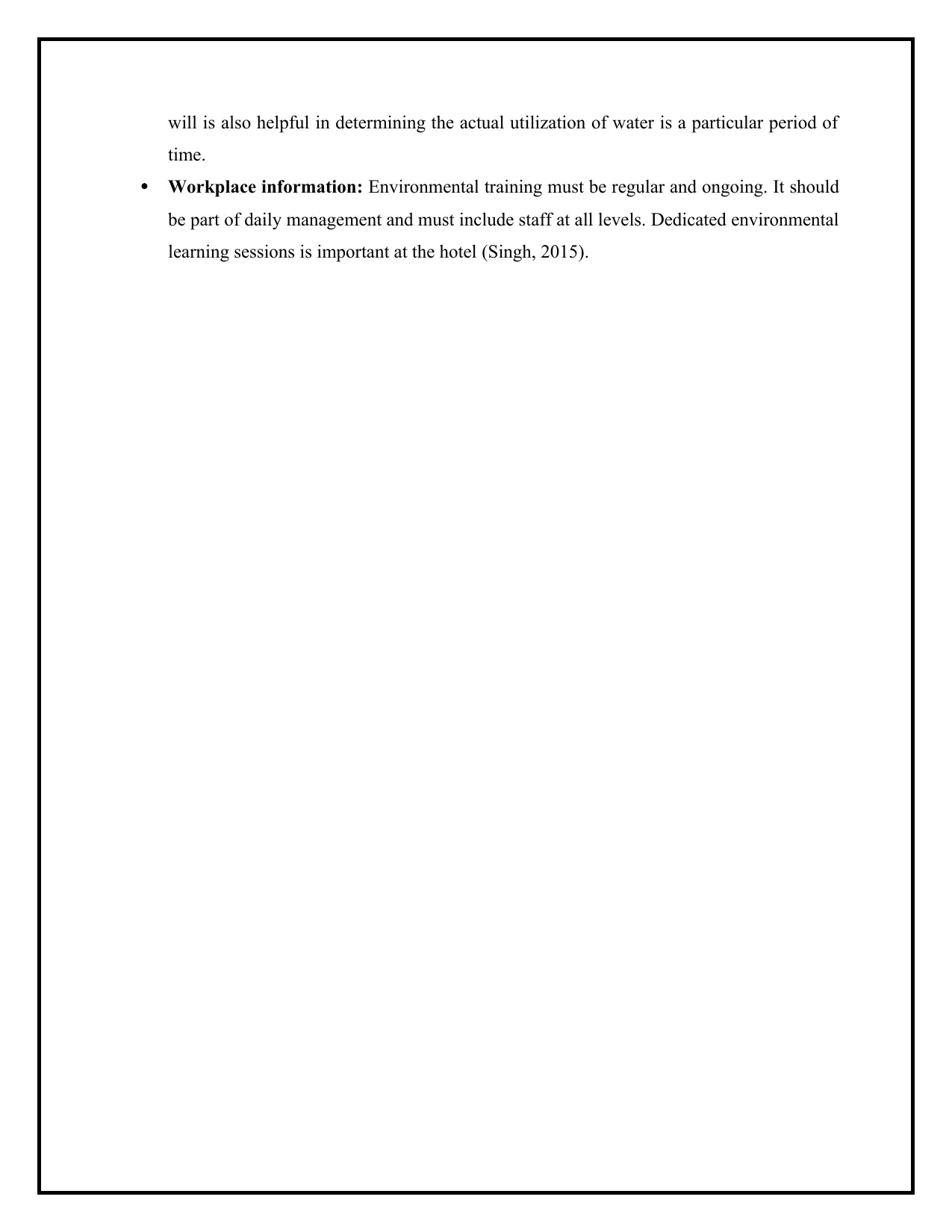
will is also helpful in determining the actual utilization of water is a particular period of
time.
Workplace information: Environmental training must be regular and ongoing. It should
be part of daily management and must include staff at all levels. Dedicated environmental
learning sessions is important at the hotel (Singh, 2015).
time.
Workplace information: Environmental training must be regular and ongoing. It should
be part of daily management and must include staff at all levels. Dedicated environmental
learning sessions is important at the hotel (Singh, 2015).
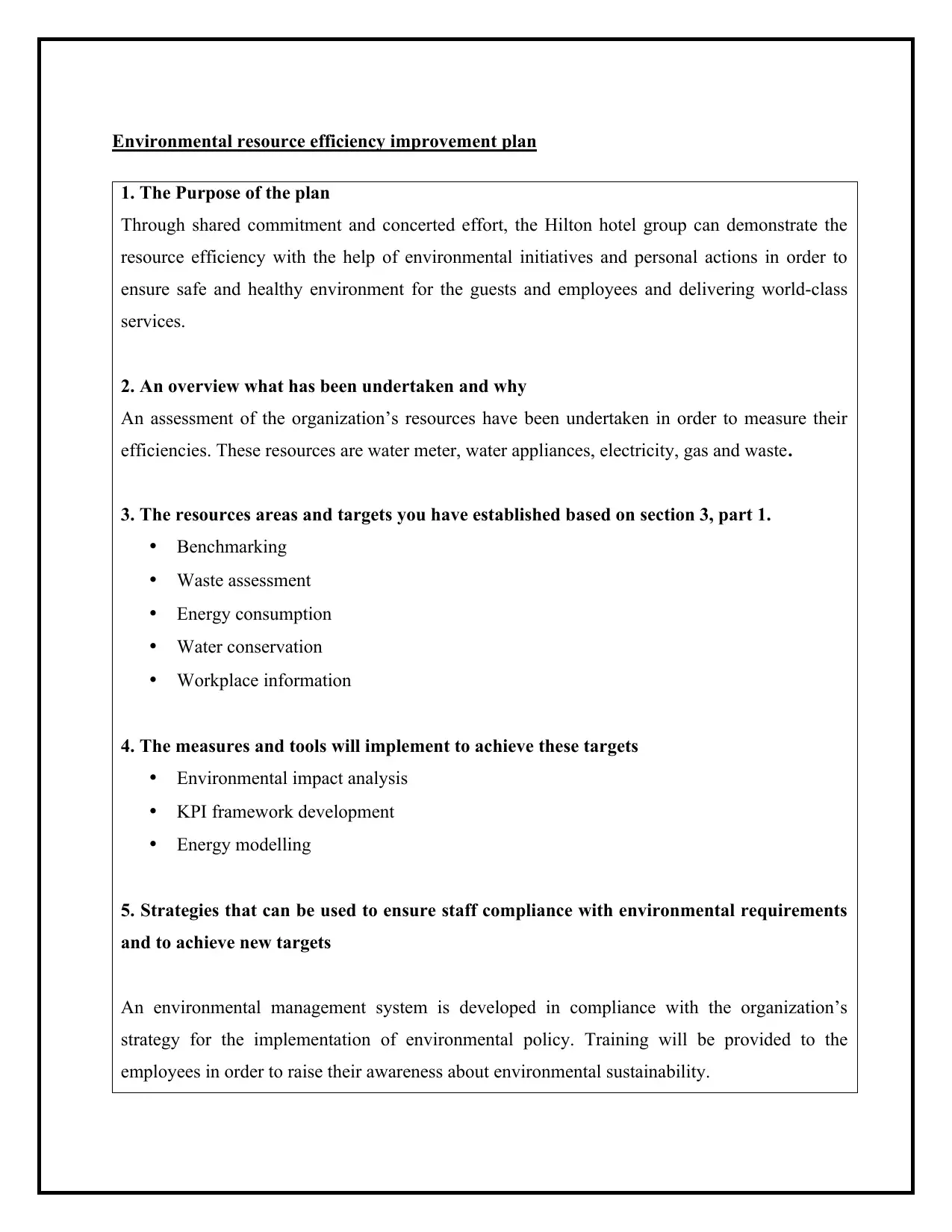
Environmental resource efficiency improvement plan
1. The Purpose of the plan
Through shared commitment and concerted effort, the Hilton hotel group can demonstrate the
resource efficiency with the help of environmental initiatives and personal actions in order to
ensure safe and healthy environment for the guests and employees and delivering world-class
services.
2. An overview what has been undertaken and why
An assessment of the organization’s resources have been undertaken in order to measure their
efficiencies. These resources are water meter, water appliances, electricity, gas and waste.
3. The resources areas and targets you have established based on section 3, part 1.
Benchmarking
Waste assessment
Energy consumption
Water conservation
Workplace information
4. The measures and tools will implement to achieve these targets
Environmental impact analysis
KPI framework development
Energy modelling
5. Strategies that can be used to ensure staff compliance with environmental requirements
and to achieve new targets
An environmental management system is developed in compliance with the organization’s
strategy for the implementation of environmental policy. Training will be provided to the
employees in order to raise their awareness about environmental sustainability.
1. The Purpose of the plan
Through shared commitment and concerted effort, the Hilton hotel group can demonstrate the
resource efficiency with the help of environmental initiatives and personal actions in order to
ensure safe and healthy environment for the guests and employees and delivering world-class
services.
2. An overview what has been undertaken and why
An assessment of the organization’s resources have been undertaken in order to measure their
efficiencies. These resources are water meter, water appliances, electricity, gas and waste.
3. The resources areas and targets you have established based on section 3, part 1.
Benchmarking
Waste assessment
Energy consumption
Water conservation
Workplace information
4. The measures and tools will implement to achieve these targets
Environmental impact analysis
KPI framework development
Energy modelling
5. Strategies that can be used to ensure staff compliance with environmental requirements
and to achieve new targets
An environmental management system is developed in compliance with the organization’s
strategy for the implementation of environmental policy. Training will be provided to the
employees in order to raise their awareness about environmental sustainability.
⊘ This is a preview!⊘
Do you want full access?
Subscribe today to unlock all pages.

Trusted by 1+ million students worldwide
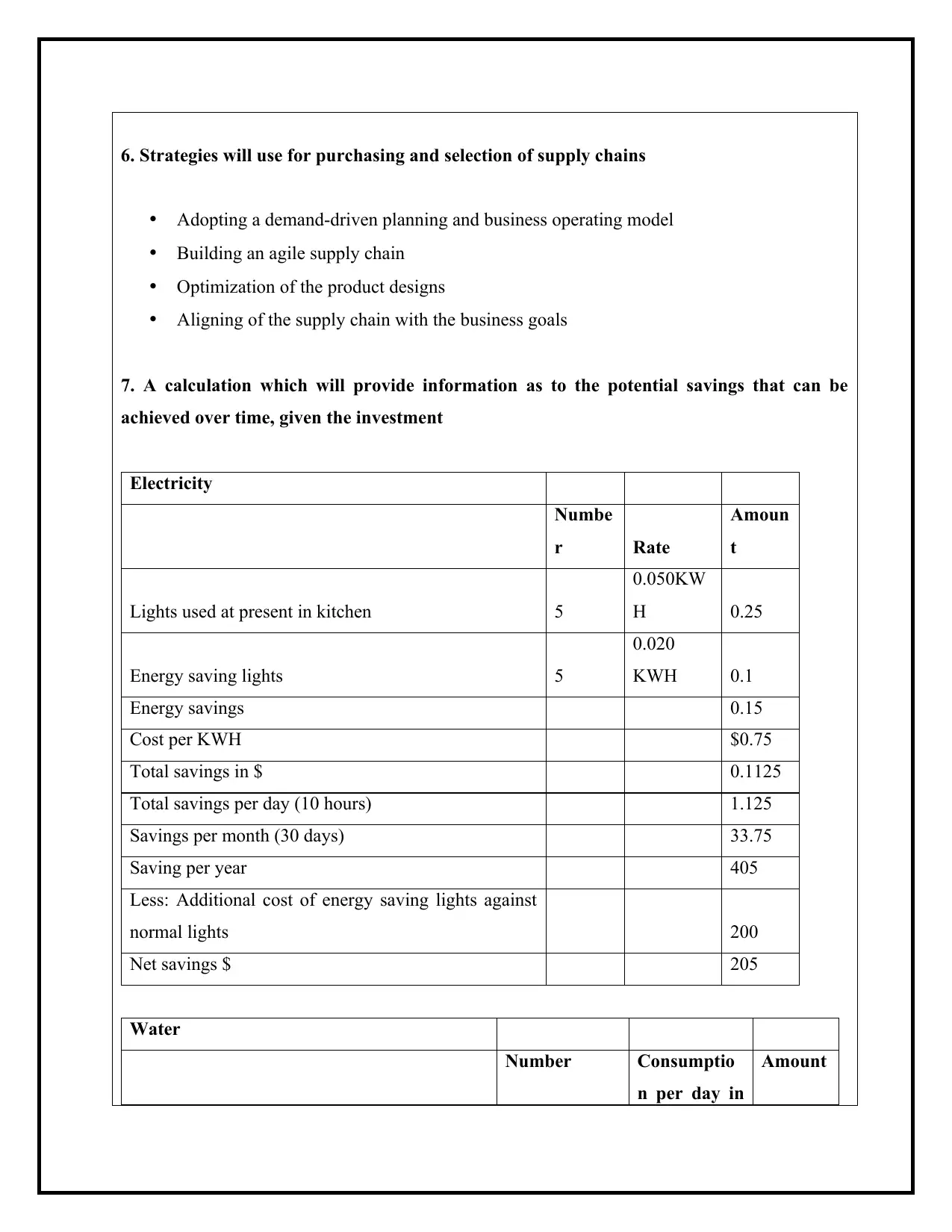
6. Strategies will use for purchasing and selection of supply chains
Adopting a demand-driven planning and business operating model
Building an agile supply chain
Optimization of the product designs
Aligning of the supply chain with the business goals
7. A calculation which will provide information as to the potential savings that can be
achieved over time, given the investment
Electricity
Numbe
r Rate
Amoun
t
Lights used at present in kitchen 5
0.050KW
H 0.25
Energy saving lights 5
0.020
KWH 0.1
Energy savings 0.15
Cost per KWH $0.75
Total savings in $ 0.1125
Total savings per day (10 hours) 1.125
Savings per month (30 days) 33.75
Saving per year 405
Less: Additional cost of energy saving lights against
normal lights 200
Net savings $ 205
Water
Number Consumptio
n per day in
Amount
Adopting a demand-driven planning and business operating model
Building an agile supply chain
Optimization of the product designs
Aligning of the supply chain with the business goals
7. A calculation which will provide information as to the potential savings that can be
achieved over time, given the investment
Electricity
Numbe
r Rate
Amoun
t
Lights used at present in kitchen 5
0.050KW
H 0.25
Energy saving lights 5
0.020
KWH 0.1
Energy savings 0.15
Cost per KWH $0.75
Total savings in $ 0.1125
Total savings per day (10 hours) 1.125
Savings per month (30 days) 33.75
Saving per year 405
Less: Additional cost of energy saving lights against
normal lights 200
Net savings $ 205
Water
Number Consumptio
n per day in
Amount
Paraphrase This Document
Need a fresh take? Get an instant paraphrase of this document with our AI Paraphraser
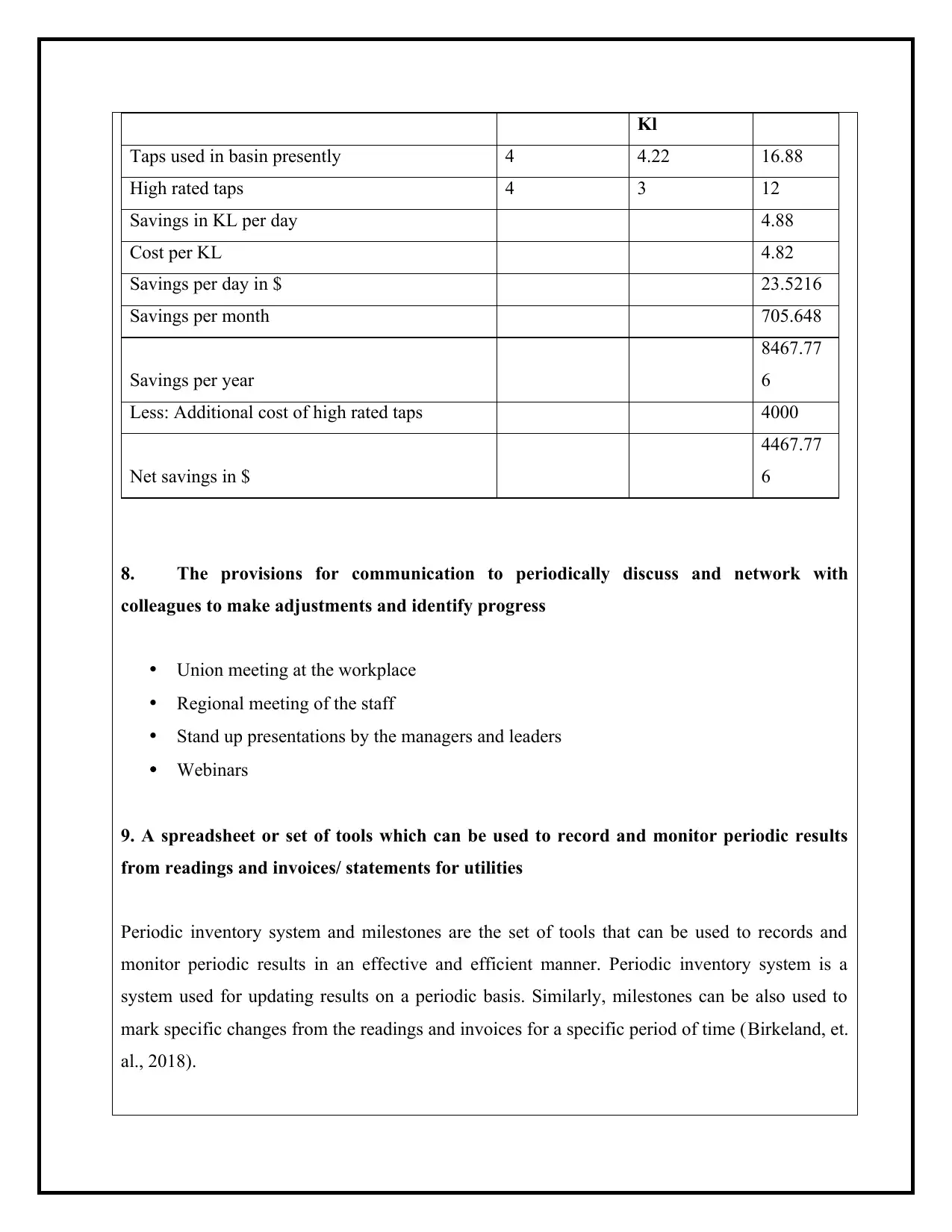
Kl
Taps used in basin presently 4 4.22 16.88
High rated taps 4 3 12
Savings in KL per day 4.88
Cost per KL 4.82
Savings per day in $ 23.5216
Savings per month 705.648
Savings per year
8467.77
6
Less: Additional cost of high rated taps 4000
Net savings in $
4467.77
6
8. The provisions for communication to periodically discuss and network with
colleagues to make adjustments and identify progress
Union meeting at the workplace
Regional meeting of the staff
Stand up presentations by the managers and leaders
Webinars
9. A spreadsheet or set of tools which can be used to record and monitor periodic results
from readings and invoices/ statements for utilities
Periodic inventory system and milestones are the set of tools that can be used to records and
monitor periodic results in an effective and efficient manner. Periodic inventory system is a
system used for updating results on a periodic basis. Similarly, milestones can be also used to
mark specific changes from the readings and invoices for a specific period of time (Birkeland, et.
al., 2018).
Taps used in basin presently 4 4.22 16.88
High rated taps 4 3 12
Savings in KL per day 4.88
Cost per KL 4.82
Savings per day in $ 23.5216
Savings per month 705.648
Savings per year
8467.77
6
Less: Additional cost of high rated taps 4000
Net savings in $
4467.77
6
8. The provisions for communication to periodically discuss and network with
colleagues to make adjustments and identify progress
Union meeting at the workplace
Regional meeting of the staff
Stand up presentations by the managers and leaders
Webinars
9. A spreadsheet or set of tools which can be used to record and monitor periodic results
from readings and invoices/ statements for utilities
Periodic inventory system and milestones are the set of tools that can be used to records and
monitor periodic results in an effective and efficient manner. Periodic inventory system is a
system used for updating results on a periodic basis. Similarly, milestones can be also used to
mark specific changes from the readings and invoices for a specific period of time (Birkeland, et.
al., 2018).
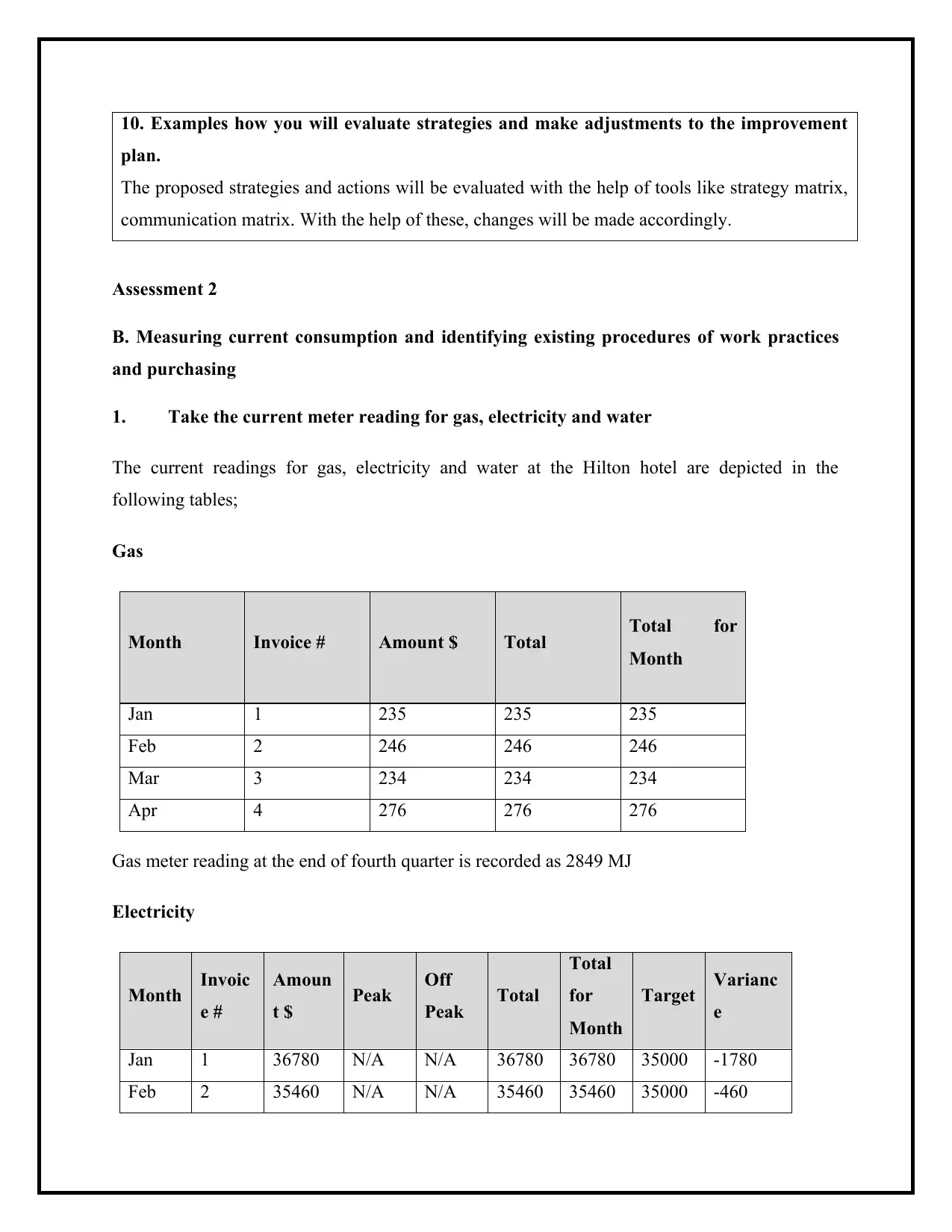
10. Examples how you will evaluate strategies and make adjustments to the improvement
plan.
The proposed strategies and actions will be evaluated with the help of tools like strategy matrix,
communication matrix. With the help of these, changes will be made accordingly.
Assessment 2
B. Measuring current consumption and identifying existing procedures of work practices
and purchasing
1. Take the current meter reading for gas, electricity and water
The current readings for gas, electricity and water at the Hilton hotel are depicted in the
following tables;
Gas
Month Invoice # Amount $ Total Total for
Month
Jan 1 235 235 235
Feb 2 246 246 246
Mar 3 234 234 234
Apr 4 276 276 276
Gas meter reading at the end of fourth quarter is recorded as 2849 MJ
Electricity
Month Invoic
e #
Amoun
t $ Peak Off
Peak Total
Total
for
Month
Target Varianc
e
Jan 1 36780 N/A N/A 36780 36780 35000 -1780
Feb 2 35460 N/A N/A 35460 35460 35000 -460
plan.
The proposed strategies and actions will be evaluated with the help of tools like strategy matrix,
communication matrix. With the help of these, changes will be made accordingly.
Assessment 2
B. Measuring current consumption and identifying existing procedures of work practices
and purchasing
1. Take the current meter reading for gas, electricity and water
The current readings for gas, electricity and water at the Hilton hotel are depicted in the
following tables;
Gas
Month Invoice # Amount $ Total Total for
Month
Jan 1 235 235 235
Feb 2 246 246 246
Mar 3 234 234 234
Apr 4 276 276 276
Gas meter reading at the end of fourth quarter is recorded as 2849 MJ
Electricity
Month Invoic
e #
Amoun
t $ Peak Off
Peak Total
Total
for
Month
Target Varianc
e
Jan 1 36780 N/A N/A 36780 36780 35000 -1780
Feb 2 35460 N/A N/A 35460 35460 35000 -460
⊘ This is a preview!⊘
Do you want full access?
Subscribe today to unlock all pages.

Trusted by 1+ million students worldwide
1 out of 22
Related Documents
Your All-in-One AI-Powered Toolkit for Academic Success.
+13062052269
info@desklib.com
Available 24*7 on WhatsApp / Email
![[object Object]](/_next/static/media/star-bottom.7253800d.svg)
Unlock your academic potential
Copyright © 2020–2025 A2Z Services. All Rights Reserved. Developed and managed by ZUCOL.





